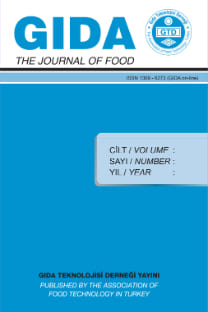CMC-GUAR GAM POLİMER AĞI İÇİN BURGER MODELİNE AİT PARAMETRELERİN MODELLENMESİ
Burger modeli, sünme-geri dönüş yanıtları, CMC-GG karışım, viskoelastikiyet, reoloji, yanıt yüzey yöntemi
MODELING OF BURGER PARAMETERS FOR CMC-GUAR GUM BASED POLYMER NETWORK
Burger model, creep-recovery responses, CMC-GG mixture, viscoelasticity, rheology, response surface methodolog,
___
- Tziboula A, Horne DS. 2000. Gums and Stabilisers for the Food Industry, 2nd ed., RSC: Cambridge.
- Mohsenin NN, Mittal JP. 1977. Use of rheological terms and correlation of compatible measurements in food texture research. J Texture Stud, 8: 395–408.
- Barnes HA, Hutton JF, Walters K. 1989. An Introduction to Rheology. J Non-Newton Fluid Mech, 32: 331-333.
- Ferry JD. 1980. Viscoelastic properties of polymers, 3rd ed., John Wiley: New York.
- Larsen DS, Tang J, Ferguson L, Morgenstern MP, James B. 2015. Textural Complexity is a Food Property – Shown Using Model Foods. Int J Food Prop, 19: 1544-1555.
- Chompoorat P, Ambardekar A, Mulvaney S, Rayas-Duarte P. 2013. Rheological Characteristics of Gluten after Modified by DATEM, Ascorbic Acid, Urea and DTT Using Creep-Recovery Test. J Mod Phys, 4: 1-8.
- Dogan M, Ersoz NB, Toker OS, Kaya Y, Canıyılmaz E. 2014. Optimization of gum combination for instant pudding based on creep and recovery parameters by mixture design approach. Eur Food Res Technol, 238: 47-58.
- Dogan M, Kayacier A, Toker ÖS, Yilmaz MT, Karaman S. 2013. Steady, dynamic, creep, and recovery analysis of ice cream mixes added with different concentrations of xanthan gum. Food Bioprocess Tech, 6: 1420–1433.
- Uzuner S, Tezel GB, Cakmak KN. 2016. Effect of temperature, gum concentration and gum ratio on creep-recovery behaviour of carboxymethyl cellulose-guar gum mixtures: modeling with RSM and ANN. Ital J Food Sci, 28: 273- 288.
- Burgers J. 1939. Mechanical considerations-model systems phenomenological theories of relaxation and of viscosity. First report on viscosity and plasticity, New York, Nordemann.
- Das S, Ghosh A. 2006. Study of creep, stress relaxation, and inverse relaxation in mulberry (Bombyx mori) and tasar (Antheraea mylitta) silk. J Appl Polym Sci, 99: 3077–3084.
- Zahangir AM, Suleyman AM, Rosmaziah W.2008. Statistical optimization of process conditions for cellulase production by liquid state bioconversion of domestic wastewater sludge. Bioresour Technol, 99: 4709-4716.
- ISSN: 1300-3070
- Yayın Aralığı: 6
- Başlangıç: 1976
- Yayıncı: Prof. Dr. İbrahim ÇAKIR
NİĞDE YÖRESİNDE TÜKETİME SUNULAN PEYNİRLERDE AKAR VARLIĞININ ARAŞTIRILMASI
Mustafa KARATEPE, Cemalettin BAĞCI, Bilge KARATEPE, Tuğba ŞENEL, Ayda KARADERE
Hilal Selamoğlu, A. Kadir Halkman
MONOSODYUM GLUTAMATIN BALIK ÇORBASI VE BALIK KÖFTESİNİN DUYUSAL ÖZELLİKLERİ ÜZERİNE ETKİSİ
Şafak Ulusoy, Hande Doğruyol, Didem Üçok Alakavuk, Ş. Yasemin Tosun
ÇEMEN EKSTRAKTI VE TİMOL İÇEREN FİLMLERLE KAPLANAN KÖFTELERİN BAZI KALİTE ÖZELLİKLERİNİN İNCELENMESİ
ISPARTA'DA ÜRETİLEN EŞEK SÜTÜNÜN KİMYASAL VE MİKROBİYOLOJİK ÖZELLİKLERİNİN BELİRLENMESİ
NOHUTTA TANE (TOHUM) KABUĞUNUN TÜM TANENİN FİZİKSEL, KİMYASAL VE BESLENME ÖZELLİKLERİ ÜZERİNE ETKİSİ
Sedat Sayar, Selen Çalışkantürk Karataş
SALGINLARA NEDEN OLAN BAZI GASTROENTERİT VİRÜSLERİNİN İRDELENMESİ
EKSİPİYAN GIDA VE EMÜLSİYONLARIN KAROTENOİD BİYOERİŞİLEBİLİRLİĞİ ÜZERİNE ETKİSİ
